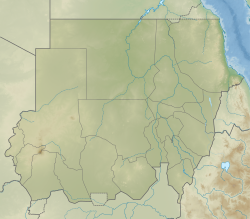 | |
| Location | Northern State, Sudan |
|---|---|
| Region | Nubia |
| Coordinates | 18°33′52″N 31°54′59″E / 18.56444°N 31.91639°E |
| Type | Settlement |
| Site notes | |
| Condition | restored |
Nuri is a place in modern Sudan on the west side of the Nile, near the Fourth Cataract. Nuri is situated about 15 km north of Sanam, and 10 km from Jebel Barkal.
Nuri is the second of three Napatan burial sites and the construction of pyramids at Nuri began when there was no longer enough space at El-Kurru.[1] More than 20 ancient pyramids belonging to Nubian kings and queens are still standing at Nuri, which served as a royal necropolis for the ancient city of Napata, the first capital of the Nubian Kingdom of Kush. It is probable that, at its apex, 80 or more pyramids stood at Nuri, marking the tombs of royals. The pyramids at Nuri were built over a period of more than three centuries, from circa 670 BCE for the oldest (pyramid of Taharqa), to around 310 BCE (pyramid of king Nastasen).

The earliest known pyramid (Nu. 1) at Nuri belongs to king Taharqa which measures 51.75 meters square by 40 or by 50 metres high.[2] The pyramid of Taharqa was situated so that when observed from Jebel Barkal at sunrise on Egyptian New Year's Day, the beginning of the annual flooding of the Nile, the sun would rise from the horizon directly over its point.[3]
Tantamani, successor of Taharqa, was buried at el-Kurru, but all following Napatan kings and many of their queens and children until Nastasen (Nu. 15) (about 315 BC) were buried here, some 80 royals.[4] The pyramids at Nuri are, in general, smaller than the Egyptian ones and are today often heavily degraded (caused by both humans and nature), but often still contained substantial parts of the funerary equipment of the Kushite rulers who were buried here. During the Christian era, a church was erected here.[5] The church was built at least in part from reused pyramid stones, including several stelae originally coming from the pyramid chapels.
The pyramids were partially excavated by George Reisner in the early 20th century. In 2018, a new archaeological expedition began work at the site, directed by Pearce Paul Creasman.[6]
The pyramids of Nuri, together with other buildings in the region around Gebel Barkal, have been placed on the UNESCO list of World Heritage Site since 2003.[7]
- ^ Wilson, John A. (1958). "Review of The Royal Cemeteries of Kush. II. Nuri". Journal of Near Eastern Studies. 17 (2): 152–155. doi:10.1086/371459. ISSN 0022-2968. JSTOR 542625.
- ^ The Pyramids of Nuri
- ^ Timothy Kendall; 2002; Napatan temples: A case study from Gebel Barkal. Gebel Barkal, the Mythological Nubian Origin of Egyptian kingship, and the Formation of the Napatan state; pp.67-69.
- ^ Compare the list in Derek A. Welsby: The Kingdom of Kush. British Museum Press, London 1996, pp. 207-208 ISBN 0-7141-0986-X
- ^ Dunham, The Royal Cemeteries of Kush II, Nuri, fig. 216
- ^ Updates for the expedition can be found online.
- ^ Gebel Barkal and the Sites of the Napatan Region at UNESCO.org

